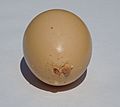Eggshell facts for kids
An eggshell is the tough, outer covering of an egg. It helps protect the growing embryo inside. This special shell is a key feature of the cleidoic egg. The cleidoic egg allowed amniotes to live and reproduce on land.
Contents
How Eggshells Protect Eggs
Eggshells are amazing natural protectors. They keep the egg safe from many dangers.
Protection from Damage
The strong shell protects the soft inside of the egg from physical harm. It acts like a tiny suit of armor. This keeps the embryo safe as it develops.
Keeping Out Germs
Eggshells also stop tiny microbes like bacteria from getting inside. This helps keep the egg clean and healthy. The shell acts as a barrier against harmful invaders.
Stopping the Egg from Drying Out
One of the most important jobs of the eggshell is to prevent the egg from drying out. It holds in moisture, which is vital for the embryo's growth. This is especially important for eggs laid on dry land.
Letting Air In
Even though eggshells are strong, they have tiny pores. These tiny holes allow small molecules like gases to pass through. This means the embryo can breathe, taking in oxygen and releasing carbon dioxide.
Providing Calcium for Growth
The eggshell is mostly made of calcium carbonate. This calcium is used by the growing embryo. It helps the embryo build its own skeleton and bones.
Different Kinds of Eggshells
Not all eggshells are the same. Their look and feel can depend on the animal that laid them.
Reptile Eggshells
Many reptiles lay eggs with flexible, leathery shells. These shells can feel soft and bendy. For example, snake eggs often have leathery shells that can stick together.
Some reptiles, like certain turtles and tortoises, lay hard eggs. These eggs are much firmer. A few reptile species even lay eggs that are very similar to bird eggs.
Bird Eggshells
A normal bird egg has several layers. Inside the hard shell, there are two thin membranes. Then comes the albumen, or egg white. The yolk is at the center, where the fertilized egg sits.
Most bird eggshells, like those from a chicken, are made of 95-97% calcium carbonate. These tiny crystals are held together by a special protein structure. This protein matrix is very important for making the shell strong. It helps the crystals form correctly.
A laying hen takes about 20 hours to make one eggshell. The shell gets its color from special pigments. These pigments are added by tiny structures inside the hen's body. This is why bird eggs come in so many different colors and patterns.
Related pages
Images for kids
See also
 In Spanish: Cáscara de huevo para niños
In Spanish: Cáscara de huevo para niños








